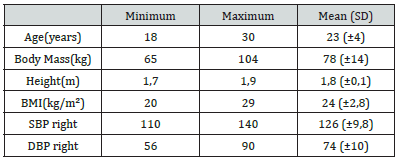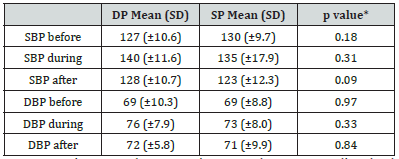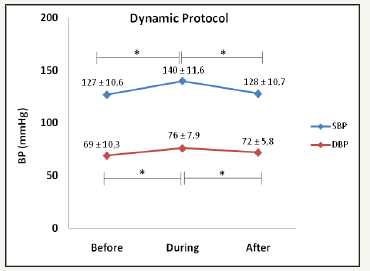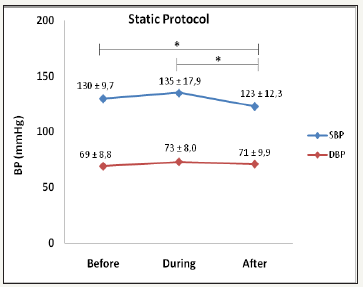- Submissions

Full Text
Open Journal of Cardiology & Heart Diseases
Do Static Contractions Result in Blood Pressure Levels Higher Than Dynamic Contractions in A Resistance Training?
Diego Passos Diogo1,2, 3, Pedro Henrique Silva Santos1, Helaynne Bezerra Nascimento1, Alan Carlos Nery dos Santos2,3, Ana Marice Teixeira Ladeia2 and Jefferson Petto1,2,3,4*
1 Universidade Estadual de Feira de Santana, Brazil
2 Escola Bahiana de Medicina e Saúde Pública, Brazil
3 Universidade Salvador, Brazil
4 Faculdade Adventista da Bahia, Brazil
*Corresponding author: Jefferson Petto, Universidade Estadual de Feira de Santana, Escola Bahiana de Medicina e Saúde Pública, Universidade Salvador, Av. Oceânica, 2717, Ondina, 40170-110, Brazil
Submission: February 16, 2018;Published: April 27, 2018

ISSN 2578-0204Volume1 Issue5
Abstract
Currently, athletes with the aim of improving their physical performance or even those into functional rehabilitation programs have had the benefits of resistance training (RT). The suitable adjustment of variables during their prescription, such as the type of muscle contraction, weight, and number of exercises repetitions and the recovering time between one set and another must be considered to achieve the aimed adaptations. Studies which have evaluated those variables about the impact on cardiovascular system have brought out some questions referring to changes in the kinds of contractions, dynamics or statics, on hemodynamic parameters. Comprehending the hemodynamics repercussions of those exercise modalities is determinant for a safe and efficient prescription. Therefore, the aim of this investigation is to compare the acute effects of dynamic and static sub maximal RT on the blood pressure of young beginner. The study included men, normotensives, practicing RT for at least 3 months. After determining the training load, the participants conducted two protocols of one-sided arm curls with 2-day interval among them: dynamic protocol (DP) and static protocol (SP). The values of their systolic blood pressure (SBP) and diastolic blood pressure (DBP) were measured before, during and after exercise. 28 participants were evaluated with 23±4 years old and BMI of 24±2.8kg/m2. The averages of the SBP before, during and after the DP and SP protocols were respectively 127mmHg (±10.6), 140mmHg (±11.6), 128mmHg (±10.7) e 130mmHg (±9.7), 135mmHg (±17.9), 123mmHg (±12.3). The averages of the DBP before, during and after the DP and SP protocols were respectively 69mmHg (±10.3), 76mmHg (±7.9), 72mmHg (±5.8) e 69mmHg (±8.8), 73mmHg (±8.0), 71mmHg (±9.9), where there were no significant statistical differences (p >0.05). Thus, there were no differences between the SBP and DBP values on the tested protocols.
Keywords: Resistance training; Blood pressure; Isometric contraction; Isotonic contraction
Introduction
The normal practice of physical exercises has been used for different populations with distinct purposes. Since athletes that search for improvement within their performance of sports modality they practice, or even those who are participating in functional rehabilitation programs, have benefited from the effects of regular exercise practice. Over all modalities, resistance training (RT) has frequently been included in training programs resulting in strength and muscle hypertrophy improvement besides changing the body composition [1].
The cardiovascular system, which is responsible for maintaining adequate blood perfusion to peripheral tissues suffers important alterations during RT execution, once it is known that the loads higher than 30% of 1 maximum repetition (MR) increase the peripheral vascular resistance resulting in the elevation of blood pressure (BP) and heart rate (HR) [2-4]. The interrelation amongst intensity (load to move), the muscles involved over exercises, the kind of muscle contraction and number of sets and repetitions define the magnitude of the hemodynamic response. It was verified by Battagin et al. [5] where they found a tendency of systolic blood pressure (SBP) being higher when RT was performed with bigger muscle groups and elevated loads. In relation to the contraction type, it is known that even in dynamic contractions there is a static component being directly proportional to the used [6] load. Participants within the RT programs such as bodybuilders and weightlifters perform local dynamics exercises most of times, resulting in an important static component. The purpose of having two phases of contraction on this condition, the SBP and diastolic blood pressure (DBP) have a tendency of increasing and decreasing their values at the concentric phase (positive phase) and eccentric phase (negative phase), respectively [3]. So as, it suggests that the use of exercises with dynamic contractions reduces the BP increment when it is compared to static exercises, hypothesizing to be a safer option during RT prescription. In some clinical conditions or specific sports modalities, static contractions have been the chosen option. There is a consensus that the BP response in those two kinds of contractions, dynamic and static, depends on the load and duration of the exercise. However, there is a lack of understanding regarding the BP given response when there are variables such as load support time, the muscle mass and load involved equalized during those two kinds of muscle contraction. Therefore, the aim of this research is to compare the acute effects of dynamic and static submaximal RT on the arterial blood pressure of a novice.
Materials and Methods
This research is a longitudinal quasi-experimental study. A convenient sample acquired in which it enrolled normotensive young men aged between 18 and 30 years old, practicing RT for at least 3 months. Participants with any muscle-orthopedic limitation, history of alcoholism, smoking and body mass index (BMI) higher than 30kg/m² were excluded. Both volunteers’ assessments and test protocols carried out at Fênix Fitness Gym in Feira de Santana, Bahia, Brazil. The sample size calculation was performed on GraphPad StatMate 2.0 for Windows program, with an alpha of 5% and beta of 80%. A significant difference of 20% was considered between the blood pressure of dynamic and static protocol which resulted in 22 participants.
Physical and clinical evaluation
The volunteers completed a health-history questionnaire and underwent a physical exam. Both were aimed in obtaining general information about them. The physical exam was conclude with BP measurement in rest, total body mass, and height. The results of this exam were cross-referenced with the protocol to determine their respective exercise load.
The BP measurement in rest was performed in sitting position, with both arms positioned at the same level of the heart, being considered the highest value. An automatic BP monitor was used (Omron HEM-742INT) with armlet of 220-320 millimeters of circumference, calibrated and approved by the Metrology National Institute (number 096/2008) [7]. The device has an oscillometric measurement method, which is able to measure among the ranges of 0-299mmHg. The volunteers were classified as normotensive according to the VI Hypertension Brazilian Guideline [8], which consists of BP values lower than 140/90mmHg. For height measurement, a professional stadiometer Sanny with 0.1cm precision was used. The volunteers performed the measurements without footwear, with their body in an upright position. The total body mass was measured with a digital balance Camry with a maximum capacity of 150kilograms which was then evaluated by the Metrology National Institute with its own certification in specifying margin of error of ±100g. The BMI was calculated with the height and body mass measurements according to the following ratio: BMI =mass (kg)/height² (cm). The BMI cut-off points are adopted in agreement with those recommended by the World Health Organization (2015) [9], which ranks as: underweight (BMI < 18.5); normal range (BMI: 18.5-24.9); overweight (BMI: 25-29.9) and obesity (BMI ≥30). Lastly, the load exercise was defined. For it, the participants completed a Maximum Load Prediction Test (MLPT) based on the Lombardi’s [10] protocol, which fulfilled the following: multiply the weight of each individual by the coefficient established to exercise a one-sided bicep curl so that the value found was adopted as the load test (LT). Each participant performed the maximum number of repetitions with a determined LT, being corrected based on the load adjustment table. A load of 70% of 1MR based on the Adams’s [11] protocol to perform the exercise was used. The physical and clinical evaluation came before the intervention protocols.
Intervention protocol
Subsequently the physical and clinical evaluation, the participants who were in accordance with the inclusion and exclusion criteria underwent the exercise protocols. All participants underwent two exercise protocols: the Dynamic Protocol (DP) and the Static Protocol (SP), being done dynamic and static contractions, respectively.
To perform the exercises, the participants were kept in sitting position with their feet in complete contact with the ground and their backs in an upright position, touching the backrest surface. The hip and knees joints positioned in a 90º degree angle. For the DP, after the proper positioning, the subjects completed three sets of eight repetitions of one-sided arm curls in a full range with their dominant limb. During the exercise, the time was clocked in each set. However, for the SP, the subjects completed a total of three sets of one-sided arm curl static contraction, respecting a 90º degree joint angle. Support time of each set according to the mean time of three sets of the DP was defined. For each protocol two minutes of passive recovery among the sets was respected. Three values of BP were measured for both protocols: immediately before, during (first set) and immediately after the exercise. Two days were used as intervals between each protocol. During the performance of the exercises, the BP’s measurement device and the chosen member stayed unmoved. External noises such as sound and conversations next to the participants were avoided. The participants were encouraged to breathe normally in order to avoid the Valsalva maneuver.
Statistical Analysis
To verify the data distribution, skewness and the kurtosis tests were applied, and the Shapiro-Wilk normality test. After the application of the cited criteria, the variables showed normal distribution, being described as the mean and standard deviation. For comparing the means between one protocol and another, it was applied the two-way Student T test for related samples. Besides that, the ANOVA One Way test with post-hoc of Tukey was used for an intra-protocol analysis. All analysis was performed in the Statistical Package for the Social Sciences (SPSS) 13.0 version, adopting a significant level of 5%.
Ethical Aspects
Throughout the study, it was observed the guidelines about human experimentation from Helsinki Declaration and 466/12 Resolution from National Health Council. All participants received details about the study’s purpose, risks and benefits involved and an informed consent was obtained. Those contracts filled in two ways, a volunteer in the possession and ownership of the researcher. This study was approved by the Ethics and Research Committee of the Technology and Science College-Salvador (under protocol number: 01.708-2009).
Results
Table 1:Anthropometric and clinical characteristics of sample (n=28).

BMI: Body Mass Index; SBP: Systolic Blood Pressure; DBP: Diastolic Blood Pressure; SD: Standard Deviation
Table 2:Weekly frequency, daily time and load test (n=28).

SD: Standard Deviation
A total of 28 participants were evaluated. The means and standard deviation (SD) of the anthropometric and clinical characteristics are presented in Table 1. Table 2 describes the weekly frequency of resistance training practice, daily time, as well as the values of the LT and maximum repetitions done.
Table 3:Values of SBP and DBP before, during and after exercise (n=28).

DP: Dynamic Protocol; SP: Static Protocol; SBP: Systolic Blood Pressure; DBP: Diastolic Blood Pressure; SD: Standard Deviation *t Student bidirectional test for related samples
Table 3 presents the comparisons of SBP and DBP means between the two exercise protocols. It was observed that there was not a statistical difference between the SBP and DBP values before, during and after the exercise between one tested protocol and another. Figure 1 & 2 show the pressure behavior in each protocol. For both, SBP and DBP pressures, there were statistical difference between before-during and during-after moments in the DP (p < 0.05). In the SP, there was a significant difference in the SBP between the before-after and during-after (p < 0.05), however the DBP values have not shown statistical difference among the measured moments.
Figure 1:Pressure curve during the performance of dynamic protocol.
BP: Blood Pressurel; SBP: Systolic Blood Pressure; DBP: Diastolic Blood Pressure *ANOVA One Way test with post-hoc of Tukey (p < 0.05)

Figure 2:Pressure curve during the performance of static protocol
BP: Blood Pressurel; SBP: Systolic Blood Pressure; DBP: Diastolic Blood Pressure *ANOVA One Way test with post-hoc of Tukey (p < 0.05)

Discussion
As it shows, there were no differences between the SBP and DBP values in the tested protocols. It is known that during RT many factors has impacted blood pressure responses, such as exercise intensity -if the failure of concentric muscle contraction during exercise was reached or not, muscle mass involved and the technique used for measuring the blood pressure [6].
Relating to the intensity, the study designs in which different percentages of 1 MR test are utilized in their protocols have evaluated blood pressure behavior acutely and chronically [12- 15]. The study of Fleck & Dean [12] for instance, 16 normotensive participants completed a one-sided knee extension exercise with loads of different percentages of 1 MR. The highest values of SBP and DBP registered during the exercises were verified among the ranges between 50-80% of 1MR. However, besides using just dynamic contractions the participants have executed all sets until concentric failure, different from this investigation where both of studied protocols (dynamic and static) were done in a submaximal manner. In fact, Gomides et al. [16] observed similar responses when 8 normotensive participants were requested to do two sets of knee extensions in a dynamic way with loads between 40-80% of 1MR. The highest values of blood pressure in this research were also identified around the concentric failure. This shows that the relation between loads used and the exercise maintenance time are more important than the kind of contraction done for the same load. It has been shown that exercises performed close to 100% of 1 MR result in pressure peak which is significantly smaller than those with a low intensity performed until the concentric failure, even having static element predominance at the maximum load exercise Fleck & Dean [12]. This idea corroborates with the findings of this investigation, due to the use of the same load and time that muscle groups have been under tension in both protocols. Thus, it shows that exercise performance, either in a static or dynamic manner, is not the main condition to the variation of blood pressure levels.
Another important factor that may induce it is the muscle mass involved. Knowing that BP is the product of cardiac output multiplied by the peripheral vascular resistance, it is suggested that the raise of BP is directly proportional to the size and quantity of muscles involved in the exercise, once the vasculature suffers mechanic compression by the muscle contraction it results in an elevated left ventricular afterload [6,17]. Some researchers did not find this relation [18,19], while others have confirmed this hypothesis [20,21]. Nevertheless, in this research, this variable was nullified once it was used the same exercise for both protocols.
As it was previously shown, the percentage (70%) of 1 MR used was obtained through a predictive equation [11]. Investigations have been completed in order to establish an adequate validation of these prediction methods. In fact, Menêses et al. [22] have established a strong correlation between the tentative method and Adams’s equation for upper limbs in trained subjects. However, although the investigation has been performed with sedentary subjects, Petto et al. [23] have shown an important variation in the number of repetition when this equation was used. Interestingly, in this research similar results also occurred (Table 2). Thus, the variability of the maximum number of repetitions among the participants would infer a sub estimation of the exercise load, not resulting in an important increase of the blood pressure values during the tested protocols.
Another highly important variable during the number of repetitions of the BP assessment in exercise condition or even in rest condition is the measurement method used. The direct intra-arterial method has been considered the golden standard for evaluating BP. However, it is unusual to use its application at the clinical practice, being commonly substituted for the indirect auscultatory method [3]. The auscultatory method, which is even accepted by national and international institutions [8,24], provides underestimated values when these are compared with the values measured by the direct method. In the Wiecek et al. [25] investigation, 5 men simultaneously underwent the auscultation and direct intra-arterial method for the evaluation of BP before, during and immediately after they performed the leg press exercise. It was seen SBP underestimated values in approximately 13%, 14% and 30% respectively. However, despite these differences it was made known, the scientific community accepted the applicability of the indirect auscultation method.
Since the 1980’s, automatic measurement devices have been manufactured, as it can be observed in the study of Egmond et al. [26] in which two brands of oscillometric devices have shown reasonable correlation with the intra-arterial measurement. Currently, several models are found in the marketplace with assured reliability by national and international institutions, being also used for scientific investigations [7,24,27-29]. In relation to the application of those devices during scientific investigations with participants in exercise conditions; few questionings have been used about its reliability. In fact, automatic devices utilizing the oscillometric method have a higher sensibility to external noises and movements of the member under measurement. However, the studies which have used this option, demonstrate an adequate control of these variables, showing satisfactory results [29]. In this investigation, the device and the member that was being measured the BP values were rested on a table during the three moments of the measurement, attenuating this bias. Furthermore, the external noises (sound equipment, for example) were avoided, leading to believe that the pressure values by the device were not influenced.
Conclusion
According to the results found, the predominance of static or dynamic component during the muscular contraction is not the main variable over the blood pressure responses at the training resistance. When the intensity and muscular tension were equalized, both protocols have shown equal values of SBP and DBP at the three moments verified (before, during and after-exercise).
References
- Fleck SJ, Kraemer WJ (2006) Fundamentos do Treinamento de Força Muscular. (3rd edn), Artmed, Porto Alegre, Brazil.
- Laughlin MH (1999) Cardiovascular response to exercise. Am J Physiol 277(6 Pt 2): S244-S259.
- Forjaz CLM, Tinucci T (2000) A Medida da pressão arterial no exercício. Rev bras Hipertens 7(1): 79-87.
- Umpierre D, Stein R (2007) Efeitos hemodinâmicos e vasculares do treinamento resistido: implicações na doença cardiovascular. Arquivos Brasileiros de Cardiologia 89(4): 256-262.
- Battagin AM, Corso SD, Soares CLR, Ferreira S, Letícia A, et al. (2010) Resposta pressórica após exercício resistido de diferentes segmentos corporais em hipertensos. Arq Bras Cardiol 95(3): 405-411.
- Negrão CE, Barreto ACP (2010) Cardiologia do exercício: do atleta ao cardiopata. (3rd edn), Manole, São Paulo, Brazil.
- Instituto Nacional de Metrologia, Normalização e Qualidade Industrial -INMETRO (Brasil). Portaria Inmetro/Dimel n.º 264, de 16 de julho de 2009. Aprovar os modelos HEM-710INT e HEM-742INT de esfigmomanômetros eletrônicos digitais destinados à medição nãoinvasiva da pressão arterial humana, marca OMRON, e condições de aprovação especificadas [portaria na internet]. Ministério do Desenvolvimento, Indústria e Comércio Exterior.
- (2010) Sociedade brasileira de cardiologia/Sociedade brasileira de hipertensão/Sociedade brasileira de nefrologia. VI diretrizes brasileiras de hipertensão. Arq Bras Card 1(95): 1-51.
- World Health Organization (2015) 10 facts on obesity.
- Lombardi VP (1989) Beginning weight training: The safe and effective way. WC Brown, Dubuque, USA.
- Adams GM (1998) Exercise physiology laboratory manual. McGraw-Hill, Boston, USA.
- Fleck SJ, Dean LS (1987) Resistance-training experience and the pressor response during resistance exercise. J Appl Physiol 63(1): 116-120.
- Wiles JD, Coleman DA, Swaine IL (2010) The effects of performing isometric training at two exercise intensities in healthy young males. Eur J Appl Physiol 108(3): 419-428.
- De Souza JC, Tibana RA, Cavaglieri CR, Vieira DC, De Sousa NM, et al. (2013) Resistance exercise leading to failure versus not to failure: effects on cardiovascular control. BMC Cardiovasc Disord 13: 105.
- Figueiredo T, Rhea MR, Peterson M, Miranda H, Bentes CM, et al. (2015) Influence of number of sets on blood pressure and heart rate variability after a strength training session. J Strength Cond Res 29(6): 1556-1563.
- Gomides RS, Nery SS, Mion Júnior D, Tinucci T, Forjaz CLM (2007) Pressão arterial durante o exercício resistido de diferentes intensidades em indivíduos hipertensos. Coleção Pesquisa em Educação Física 6: 435- 442.
- Gottschall CAM (2005) Dinâmica Cardiovascular: do miócito à maratona. Atheneu, São Paulo, Brazil.
- Polito MD, Rosa CC, Schardong P (2004) Respostas cardiovasculares agudas na extensão do joelho realizada em diferentes formas de execução. Rev Bras Med Esporte 10(3): 173-176.
- D’Assunção W, Daltro M, Simão R, Polito M, Monteiro W (2007) Respostas cardiovasculares agudas no treinamento de força conduzido em exercícios para grandes e pequenos grupamentos musculares. Rev Bras Med Esporte 13(2): 118-122.
- Seals DR, Washburn RA, Hanson PG, Painter PL, Nagle FJ (1983) Increased cardiovascular response to static contraction of larger muscle groups. J Appl Physiol Respir Environ Exerc Physiol 54(2): 434-437.
- McCartney N (1999) Acute responses to resistance training and safety. Med Sci Sports Exerc 31(1): 31-37.
- Menêses AL, Soares AHG, Souza BCC, Souza DJCA, Cyrino ES, et al. (2013) Validade das equações preditivas de uma repetição máxima varia de acordo com o exercício realizado em adultos jovens treinados. Revista Brasileira de Atividade Física & Saúde 18(1): 95-104.
- Petto J, Santos LTA, Gomes VA, Oliveira FTO, Garcia NL, et al. (2015) Número de repetições em diferentes porcentagens de carga máxima de exercícios neuromusculares. Con Scientiae Saúde 14(4): 577-584.
- British Hypertension Society (2016) BP Monitors.
- Wiecek EM, McCartney N, McKelvie RS (1990) Comparison of direct and indirect measures of systemic arterial pressure during weightlifting in coronary artery disease. Am J Cardiol 66(15): 1065-1069.
- Van Egmond J, Hasenbos M, Crul JF (1985) Invasive v. non-invasive measurement of arterial pressure. Br J Anaesth 57(4): 434-444.
- O’Brien E, Asmar R, Beilin L, Imai Y, Mallion JM, et al. (2003) European Society of Hypertension recommendations for conventional, ambulatory and home blood pressure measurement. J Hypertens 21(5): 821-848.
- Christofaro DGD, Fernandes RA, Gerage AM, Alves MJ, Polito MD, et al. (2009) Validação do monitor de medida de pressão arterial Omron HEM 742 em adolescentes. Arq Bras Cardiol 92(1): 10-15.
- Araújo CGS, Duarte CV, Gonçalves FA, Medeiros HBO, Lemos FA, et al. (2011) Respostas hemodinâmicas a um protocolo de treinamento isométrico de preensão manual. Arquivos Brasileiros de Cardiologia 97(5): 413-419.
© 2018 Jefferson Petto. This is an open access article distributed under the terms of the Creative Commons Attribution License , which permits unrestricted use, distribution, and build upon your work non-commercially.
 a Creative Commons Attribution 4.0 International License. Based on a work at www.crimsonpublishers.com.
Best viewed in
a Creative Commons Attribution 4.0 International License. Based on a work at www.crimsonpublishers.com.
Best viewed in 







.jpg)






























 Editorial Board Registrations
Editorial Board Registrations Submit your Article
Submit your Article Refer a Friend
Refer a Friend Advertise With Us
Advertise With Us
.jpg)






.jpg)














.bmp)
.jpg)
.png)
.jpg)










.jpg)






.png)

.png)



.png)






